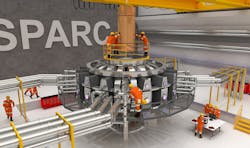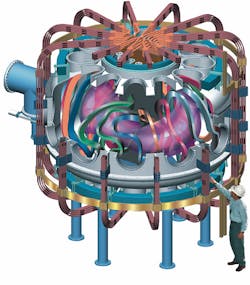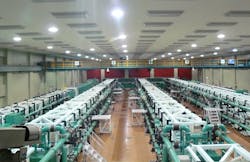Scientists have been chasing fusion energy since the early 20th century as a source of safe, clean, and virtually unlimited power source. They have yet to find a way to capture and sustain the energy produced in any viable manner. That’s not to say there haven’t been advances and technological breakthroughs over the decades to harness the power of the sun. In fact, a collaboration between MIT and Commonwealth Fusion Systems may produce a working pilot plant in the next 15 years. But in order to understand the future, we need to take a look at the past.
This is a 3D design rendering of possible fusion reactor for power generation. (Courtesy of USA Gov. via Wikipedia)
Initially, fusion research from the U.S. and USSR went hand in hand with atomic weapons development. It remained classified until a bunch of scientists and government officials got together between the two countries for a sort of “show and tell” meeting of fusion research at the “Atoms for Peace” conference back in 1958.
For the U.S. at that time, the first successful controlled nuclear fusion experiment was accomplished by scientists at Los Alamos National Laboratory using Scylla I, a theta-pinch machine that essentially compresses plasma (normally deuterium and tritium) using magnetic fields. This process raised the temperature of the plasma to 15 million degrees Celsius, high enough to fuse atoms and produce neutrons.
The Soviets during that time had success with a tokamak device, which also uses a powerful magnetic field to compress hot plasma into the shape of a torus (or doughnut), thereby stabilizing the plasma and achieving fusion. The design is thought to be the leading device for sustaining controlled thermonuclear power for a practical reactor even to this date.
Beyond magnetic pinches and confinement systems to create and contain fusion power, other approaches include inertial confinement using lasers to super-heat pellet fuel to achieve a sustained reaction. Another option, electrostatic confinement, applies an electric field to heat ions up to fusion conditions.
Osaka University’s GEKKO XII inertial confinement platform for fusion experiments. (Courtesy of Kasuga, Sho via Wikipedia)
With fusion reactors, the concept revolves around neutrons generated from a deuterium and tritium reaction that will be absorbed by a blanket of lithium surrounding the core. That lithium is then transformed into tritium (and helium), thus producing more fuel, sustaining a chain reaction. The kinetic energy of the neutrons is absorbed by the lithium blanket, causing it to heat up and subsequently be collected by a coolant, and ultimately be used to generate electricity by conventional methods. The problem is that scientists haven’t developed a device that can heat the fuel to a high-enough temperature and confine it long enough to achieve the sustained chain reaction necessary for practical fusion power.
What’s the Latest?
MIT and Commonwealth Fusion Systems are working to develop a novel approach to the problem of fusion containment. They’re using high-temperature superconductors to contain the sustained reactions that would otherwise melt conventional solid materials. Researchers from both institutes plan to develop new superconducting magnets using a steel-tape material coated with a unique compound containing yttrium-barium-copper oxide.
MIT states it will develop these new magnets over a three-year period. After which, they will be used in a fusion reaction experiment utilizing SPARC—a compact, high-field, net fusion energy reactor system. The system is designed to produce about 100 MW of heat or enough energy to power a small city, although the experiment will not generate electricity.
MIT’s approach to fusion energy containment will use high-temperature superconductors to enclose the energy. (Courtesy of MIT)
According to the MIT press release, “This demonstration would establish that a new power plant of about twice SPARC’s diameter, capable of producing commercially viable net power output, could go ahead toward final design and construction. Such a plant would become the world’s first true fusion power plant, with a capacity of 200 MW of electricity, comparable to that of most modern commercial electric power plants.”
It would be an astounding technological milestone if they can achieve the goal of producing a pilot plant in less than two decades. Being able to harness the power of the sun through a contained chain fusion reaction is something that has always been “a few decades away,” just out of reach. The question of whether or not they will succeed will be answered as the years pass by, but even the most skeptical mind may waver considering MIT is at the helm.
About the Author
Cabe Atwell
Technology Editor, Electronic Design
Cabe is a Technology Editor for Electronic Design.
Engineer, Machinist, Maker, Writer. A graduate Electrical Engineer actively plying his expertise in the industry and at his company, Gunhead. When not designing/building, he creates a steady torrent of projects and content in the media world. Many of his projects and articles are online at element14 & SolidSmack, industry-focused work at EETimes & EDN, and offbeat articles at Make Magazine. Currently, you can find him hosting webinars and contributing to Electronic Design and Machine Design.
Cabe is an electrical engineer, design consultant and author with 25 years’ experience. His most recent book is “Essential 555 IC: Design, Configure, and Create Clever Circuits”
Cabe writes the Engineering on Friday blog on Electronic Design.





